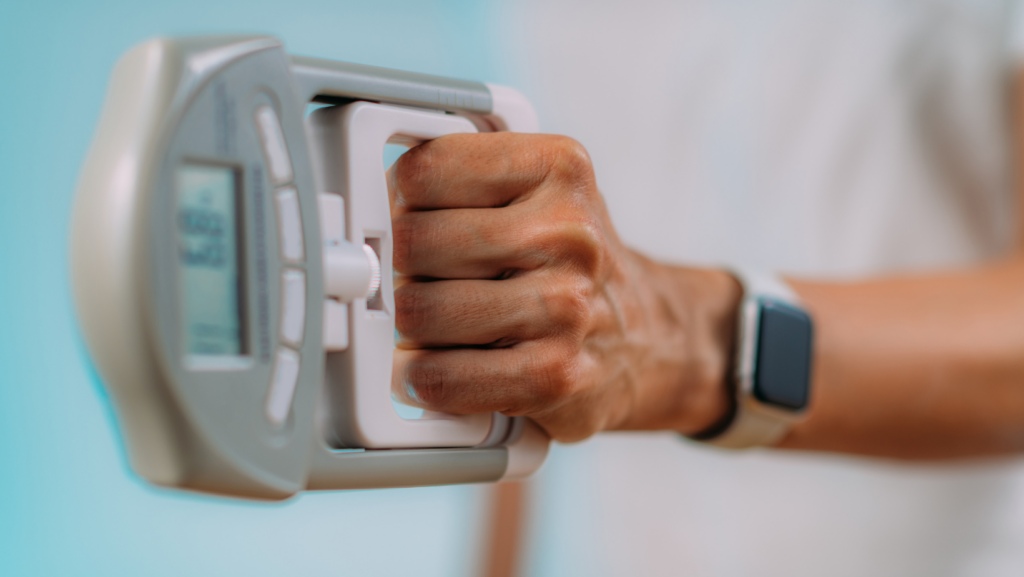Your grip strength is one of the best measures of your biological age – the weaker your grip, the older your biological age, regardless of your gender. This is because your grip is highly correlated with your overall body strength, which is a great predictor of healthy life expectancy and longevity. Effectively, the impact of muscle weakness on shortening healthy years could be equivalent to smoking on reducing life expectancy.
Exercise is probably the best single anti-ageing remedy, but this extends beyond aerobics and should include strength training, balance and stretching. All are necessary, but strength training, or resistance exercise is particularly important.
After the age of 30 we start to lose muscle mass at 3% to 5% per decade. This rate of decline accelerates as we pass age 50 and escalates even further beyond age 60. Typically, by the time you reach your 60s and 70s you’ll have lost 12% of your muscle mass and by the time you’re 80 you’ll have lost 30%. Engaging in strength exercises can delay this decline, while a sedentary lifestyle and a poor diet will hasten it.
Healthy habits are the building blocks of longevity
Building and maintaining muscle mass has two major advantages. Firstly, it has metabolic benefits, as muscles absorb glucose on their own with far less insulin, lowering blood sugar levels and reducing the risk of Type 2 diabetes. Strength training also boosts your metabolism (which slows with age) and so aids in weight management, is good for your heart health, increases testosterone levels (which also reduce with age), rejuvenates your brain by enhancing blood flow, and improves sleep quality by helping you fall asleep faster and stay asleep longer.
Secondly, muscle mass has structural benefits. Strength training promotes bone density, enhances balance, and reduces your risk of injury (which becomes more common as you age). It also accelerates recovery from injuries. Conversely, the loss of muscle mass is associated with a lower quality of life, affecting your ability to perform everyday tasks, like lifting your grandchild, pushing them on a swing and, in due course, walking, maintaining balance, or even getting up from a chair. Furthermore falls and injuries can be lifechanging over age 65.

Strength training enhances our self-esteem
The medical term for age-related loss of muscle mass or strength, is “sarcopenia”, derived from the Greek words “sarcos”, meaning flesh and “penia” meaning loss. Although life expectancy for individuals aged 60 with sarcopenia may be similar to those without it, the years they live with disability is three times greater. Whilst we can’t stop the ageing process, building up muscle mass before reaching an older age can delay or reduce the negative health effects associated with its loss.
We can add muscle mass at any age, so it’s never too late!
The good news for men is that strength training has a similar effect on ageing muscles as it does for younger ones. For women, there may be a milder response. Additionally, for those who have been inactive, the good news is that they experience the greatest benefits from their first activities.
The ideal strength training program depends on your current strength and health. If you’ve a health condition, it’s advisable to first consult your doctor or a medical professional. If you’re new to strength or resistance training, consider seeking guidance from a personal trainer to help create a program that’s right for you and incorporates your main muscle groups.
Diet also plays an important role in age-related loss of muscle mass and strength. Experts in the field of protein and ageing recommend between 1.2 and 1.5 grams of protein per kilogram of body weight per day, which is significantly greater than the typical recommendation of 0.75 grams per kilogram of body weight. This is because ageing bodies process protein less efficiently and therefore need more of it to maintain muscle mass and strength.
Older adults looking to build muscle as part of their exercise routine, should aim for 1.5 to 2.0 grams of protein per kilogram of body weight, spread evenly over three meals. For instance, an older adult weighing 70 kilograms should aim for about 30 grams of protein per meal to maintain their muscle mass and 40 grams to build their muscle mass. Note, a skinless chicken breast typically has 54 grams of protein, and half a salmon fillet has 40 grams of protein.
In summary, assessing your grip strength can help identify the potential for future functional decline and chronic diseases. One of the most effective ways to extend your healthy lifespan is by increasing your overall muscle mass. The loss of muscle mass is not inevitable and can be reversed through resistance or weight training, as well as a higher protein diet.
Let’s get a grip on healthy ageing!
For more information, please read our other blogs.
To help us make Britain one million biological years younger take our autum Lifescore calculator to determine your biological age and use our autum app on Android or IOS to help improve your biological age today!

We’re on a mission to transform how the UK’s later life population retains its health and wellbeing for longer. It all starts with biological age and our tools aim to measure, track and reduce this.
Together we will make Britain one million biological years younger.


